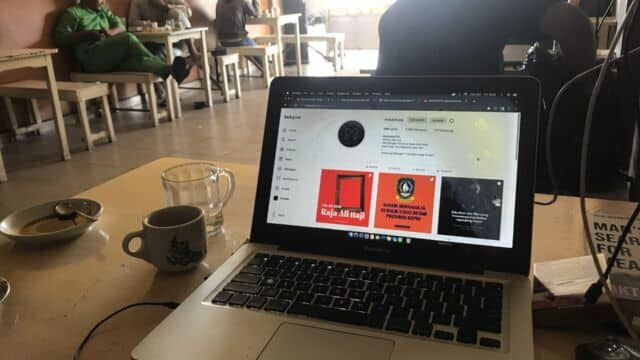For Me, Yearning Has a Taste, and It’s Oily, Spicy, and Delicious
Mak Ngah’s Nasi Lemak Resto | 2,500 words
Translated from Bahasa Indonesia by Sarah Leys
However far adulthood takes us from a place, yearning will always leave a trace and compel said adult to return, recall, and look around for what’s still left. Here in Tanjung Riau, in an old kampung in the coastal part of the city of Batam, in the Riau islands, I know yearning as the oily, spicy, delicious taste of Mak Ngah’s nasi lemak.
The resto of Mak Ngah is in a stilt-house on the beach, looking much like the other dwellings in this community, standing on concrete legs sunk into the sand. Long ago, stilt-houses here had only wooden pillars supporting them, and next to each house would stand one upright plank of wood for people to fasten the mooring ropes of their boats. Those boats were also made out of wood, and guided by oars, as only middle-to-upper-class people owned fiberglass boats with engines.
In the past most of the coastal-living people of this area were fishers who depended for their livelihoods on the sea, but now they have largely shifted to industry, because in the coastal part of Tanjung Riau right now much is getting built by foreign companies, structures soaring far over the roofs of local peoples’ houses. Starting in the distant past and continuing with the few who hang on in that livelihood now, Mak Ngah always buys from the local fishers the seafood she needs for her resto.
As far back as I can recall, thirty years, more or less, Mak Ngah’s nasi lemak has pampered the taste buds of the Malay people of this place. There’s no nameplate or neon sign on the closest roadside to Mak Ngah, nothing to signal that outstandingly enjoyable food is being sold here. Different to other nasi lemak outlets, Mak Ngah sells her delicious menu at dinner-time. She opens shortly before the Maghrib prayer, just before darkness starts its rapid crawl down.
Mak Ngah’s place is close to the dock where kids often swim during high tides. Long ago when my friends and I had had our fill of swimming in the sea, we’d often wait in front of her resto until she opened for business. Our bodies were sticky because we hadn’t washed ourselves with freshwater, just wiped ourselves down with towels as best we could, while still wearing the clothes we used to get to and from the beach. If city kids in the afternoons smell of cologne, coast kids have the aroma of salt. From then on, my hungry stomach and Mak Ngah’s nasi lemak were a pair of familiar friends, the first often requesting to greet the second.

One afternoon recently, in a WhatsApp group chat full of these old friends of mine from elementary school, an ummah-unifying message appeared:
“Mak Ngah – how about it?”
*
The WhatsApp message was sent by Lela, who lives only a few houses down from me – all but spitting distance. But this is just how it is now, right, it feels easier to say hello through messages on our devices than to go to each other’s houses. Technology: it’s efficient, but it does sometimes feel empty.
There was no need to wait long: reply messages came into the group chat in droves. Food is Indonesia’s national unifier number two, second only to the trashy hyperlinks without social use that get spread on social media. So our group was gathered, and our plan was hatched: at seven o’clock, we’d visit Mak Ngah. Almost everyone still residing in Batam confirmed their attendance. All members of our group really enjoy eating and having a good yack, like most Malay people.
Lela and I, being neighbors, decided to go there together. The sky behind the roof of Mak Ngah, which has a ground level and an upper level, was at that moment a brilliant orange. Dusk had only just vanished; the night was young. We were the first customers to arrive.
The nasi lemak itself, the shrimp sambal, and the snacks of curry puffs and roti prata are the main attractions at Mak Ngah Resto. Here the prata is miniature-sized, so very much a snack rather than a main. If you want more than twenty prata, it’s advisable you order in advance: if not, be ready to go without. For this evening’s event, of course, our supply had already been secured.
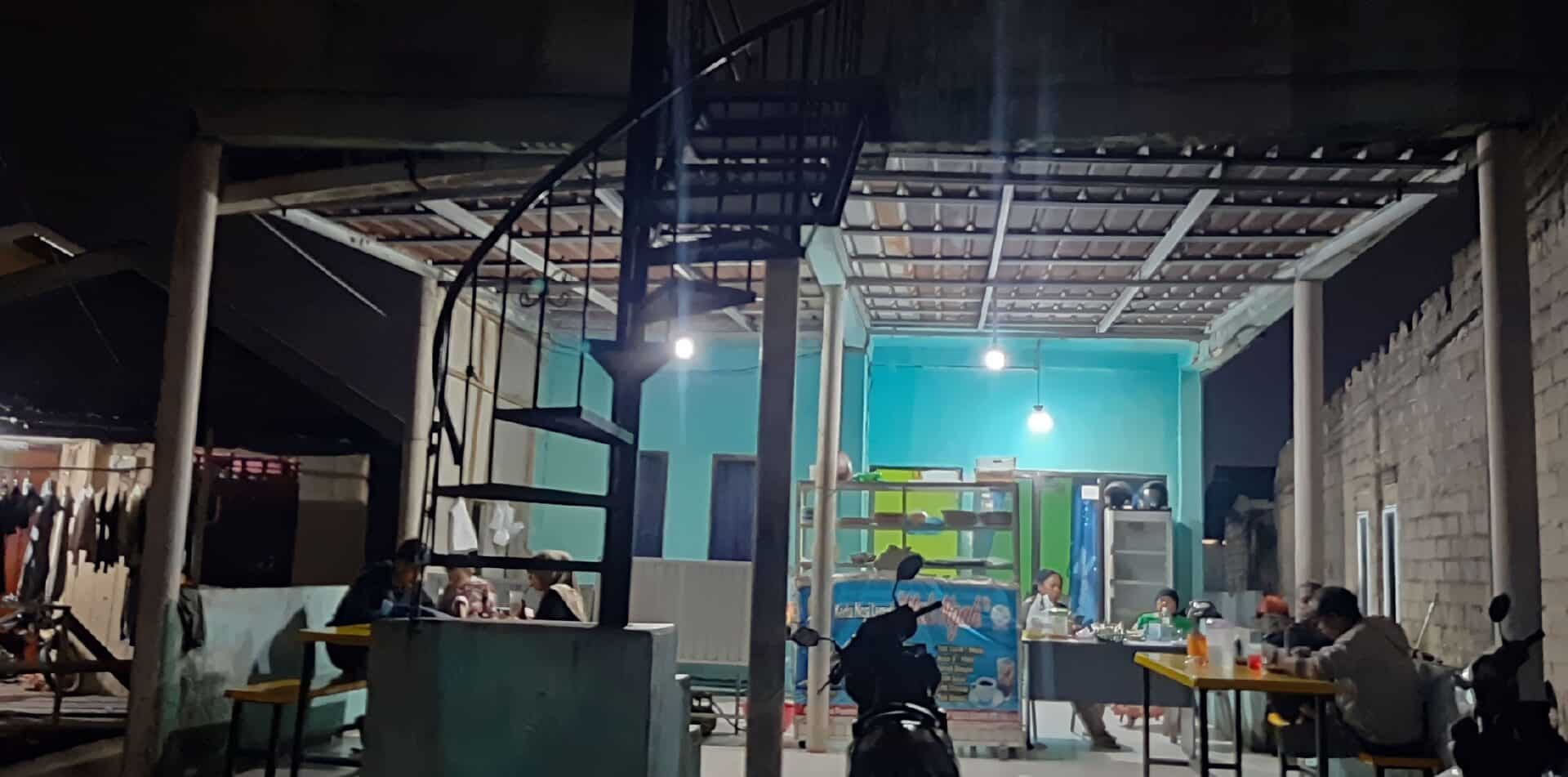
“Hi Mak Ngah, earlier we already ordered on WhatsApp, yeah?” Lela said this before she headed up to the upper storey. There’s a spiral staircase in the resto that can only accommodate one person at a time: going up and down, you’ve got to wait your turn.
For this eating together event tonight the organizers had moved fast: after people confirmed their attendance, we had made on the chat a list of what from the menu we wanted to order. We had then sent our order electronically to the inbox of Mak Ngah’s phone – almost all regulars know this middle-aged lady’s phone number.
Before following after Lela, I took the time to look at what side dishes to accompany the nasi lemak were available tonight. Mak Ngah often changes them depending on what the fishers take out of the sea and supply. Sometimes it’s squid, sometimes shrimp, sometimes both of them mixed into the one pot – that’s my favorite, an inspired collaboration of shrimp and squid.
“What are the sides today, Mak?” I asked while craning my neck to see a big tub full of dark red sambal chilli sauce. The fresh aroma of warm yellow rice, wafting up from a pink rice-warmer as high as a toddler that sat next to a glass display case stocked with other foods, made me reflexively lick my lips.
“Mixed squid and shrimp,” said Mak Ngah. “There weren’t many squid today, so they’re jumbled in with shrimp. Your favorite, right.” Yay! I emitted a cheer hearing Mak Ngah’s answer. I then busied myself reading again our recently-placed group order on my phone screen, while several workers, who lived in the surrounding houses, started plonking big spoonfuls of rice onto multi-colored plastic plates, with a layer of brown paper in between.
Mak Ngah Resto, just like us, has grown. Long ago this place was only made from ordinary wood – still with two floors, but very modest. The tables and benches were made of long pieces of wood, and the roof was low. In 2014, a fire engulfed all of it: nothing remained. But in 2015, Mak Ngah Resto opened for business again, with the same taste and same enjoyableness.
If you think about it, lasting for thirty years is no easy thing, first chewed up by fire, and then the pandemic which closed one by one other small and medium-sized businesses around here. But nothing has managed to shutter this place.
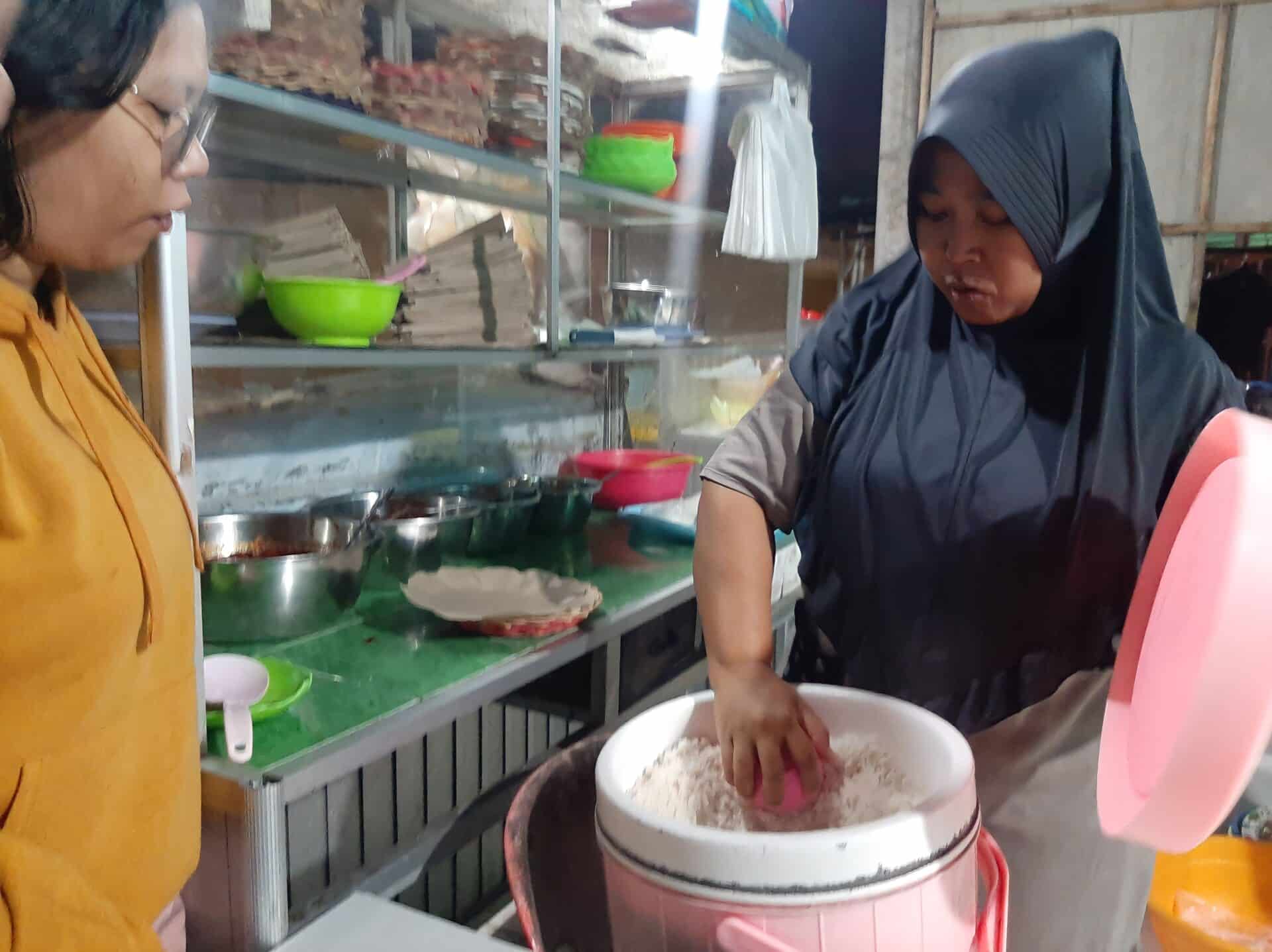
Mak Ngah’s nasi lemak restaurant doesn’t have a social media account, and has never done any special promotions on particular holiday dates. I’ve never seen any narrated video feed of it, no Instagrammer who has been invited to Mak Ngah’s to promote its menu. But the weird thing is, if I go to surrounding cities and meet someone who asks where I’m from, when I say Tanjung Riau, they straightaway bring up Mak Ngah Resto. Malay palettes, it turns out, have already spread news of the tastiness of Mak Ngah’s nasi lemak far from the steam of the kitchen where she cooks her rice.
Food already covered our table by the time all my friends arrived. I like to observe the ways food gets served: while in padang curry houses the plates are brought piled up like towers on the arms of the waitstaff, here the food gets brought out inside a large basket, which reminds me of the scenes of big parties that appear in Bollywood movies.
Although our event couldn’t be called a reunion, per se, given that most of us sitting at the table still pass by each other often while out and about, our discussion quickly began to go here, there and everywhere, just like in more typical reunions. Oh, adulthood, it feels so awkward just to greet each other on the street, sometimes people are anxious that it’s only they who recognize the other, that their old friend has already forgotten their face. Even though, at least in my eyes, nothing about us has changed. We’re just a group of people who’ve gotten taller, wider, and older. And also have a different smell coming from our bodies. The aroma of the people at this table when they were little kids—and me as well—was of sun mixed with dust and the tang of seawater. Even though our hungry stomachs tonight still demanded to be greeted by the same old menu, the smells of our bodies were palpably different, as the fragrance of perfume half-filled this table, mixing with the smell of the food served.
I glanced at the other tables as they began to be filled with other guests. At first only people living around this area were regular customers here, but in the last few years many people have started showing up who are apparently not reluctant to travel an hour or more for the sake of Mak Ngah’s nasi lemak. This night I’d made sure to order pulut kuning, yellow rice, a quintessential Malay dish usually served at large celebrations. The taste really is extraordinary, the fluffy fragrant pandan rice and scent of turmeric jolting the senses. The portions here are not too large. Deliberately so, thereby ensuring there’s still room for the snacks, the roti prata and curry puffs that now formed a mountain in the middle of our table.
At ten o’clock, several friends said goodbye. The chatting voices that remained bounced around more and more between different topics, from our respective busy lives, jobs, partners and children, until the rhinoplasty of one of my friends was mentioned. If there’s someone who has changed the most out of us, I suppose it’s her, and honestly, from when she first appeared this night, she had been the main object of discussion. Some people looked at her full of amazement, others suddenly turned into recording angels noting down a sin, but I chose to simply observe. My friend has been beautiful since forever, her Middle Eastern blood evident in her face. But there must be a reason for the decision she took.
“You’re already so pretty, why would you get a nose job?” one friend asked, foregoing niceties.
“Yeah, what can you do,” she replied, “human beings are never satisfied. I used my own money, so what’s the problem.” As the evening’s main target answered coolly in this way, everyone at the table laughed, some genuinely, others insincerely. For me, she appeared the loveliest of us on this night, for reasons unrelated to the fact of her operation.
“Dina.”
I looked over at Esti.
“You’ve changed, though – if I met you in the street, I’m not sure I’d know you.”
As she said this to me, other heads turned to face me. I grew uncomfortable, not liking being the centre of attention.
“Nope – I’m the same,” I said, while nervously sipping my drink, which now felt no longer sweet, not knowing whether I should be happy or not, whether the “change” she was going to identify was good or bad.
“You’re looking prettier these days.” And I breathed a sigh of relief.
In this legendary resto, patrons are free to sit until whatever hour they like, but orders close as soon as the pre-cooked food sells out. The space on the top floor is open to the elements, sea breeze and sometimes sea spray interspersing the clamor of each table’s talking. For views, the lamps of a few fishing boats can be seen rocking in the middle of the darkness of the sea like dancing fireflies, golden yellow. It’s this setting, as well, that makes regulars come again and again. The atmosphere indulges the eyes, and is good for thinking.
When the hour hit eleven o’clock, I decided to head home, because if not, if we were to keep chatting, we would be sleeping here. Meanwhile the owner had likely been sleeping soundly and dreaming since earlier. I can understand very well this habit of Mak Ngah, who will not delay her sleep for long after the last order is served. When the food’s sold out, Mak Ngah packs up everything that needs to be packed up, and says, “until tomorrow, then. I want to sleep, I’m very tired.” And with a lilting voice, yawning a little, she will enter the residential section of the stilt-house, followed by the sound of the door being locked.
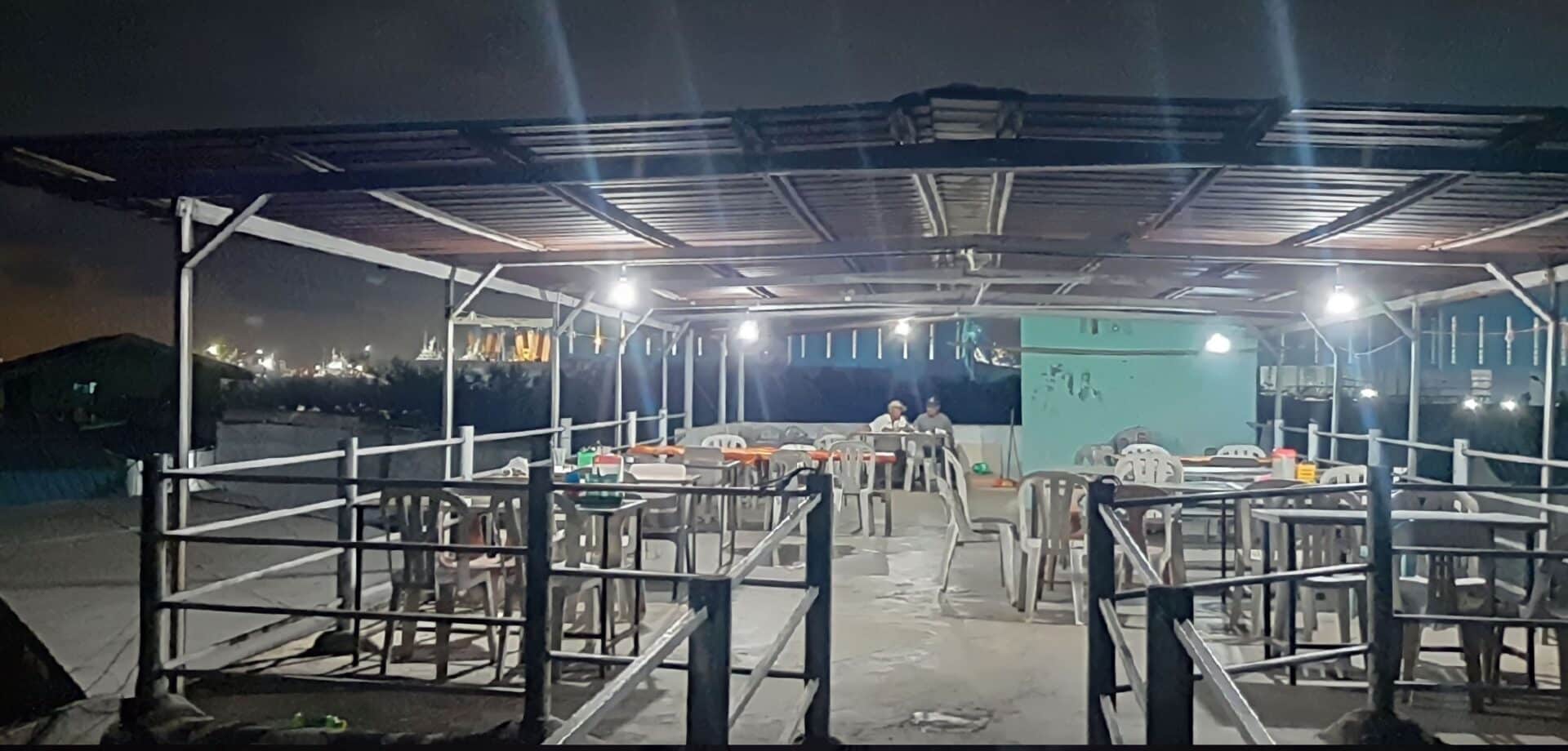
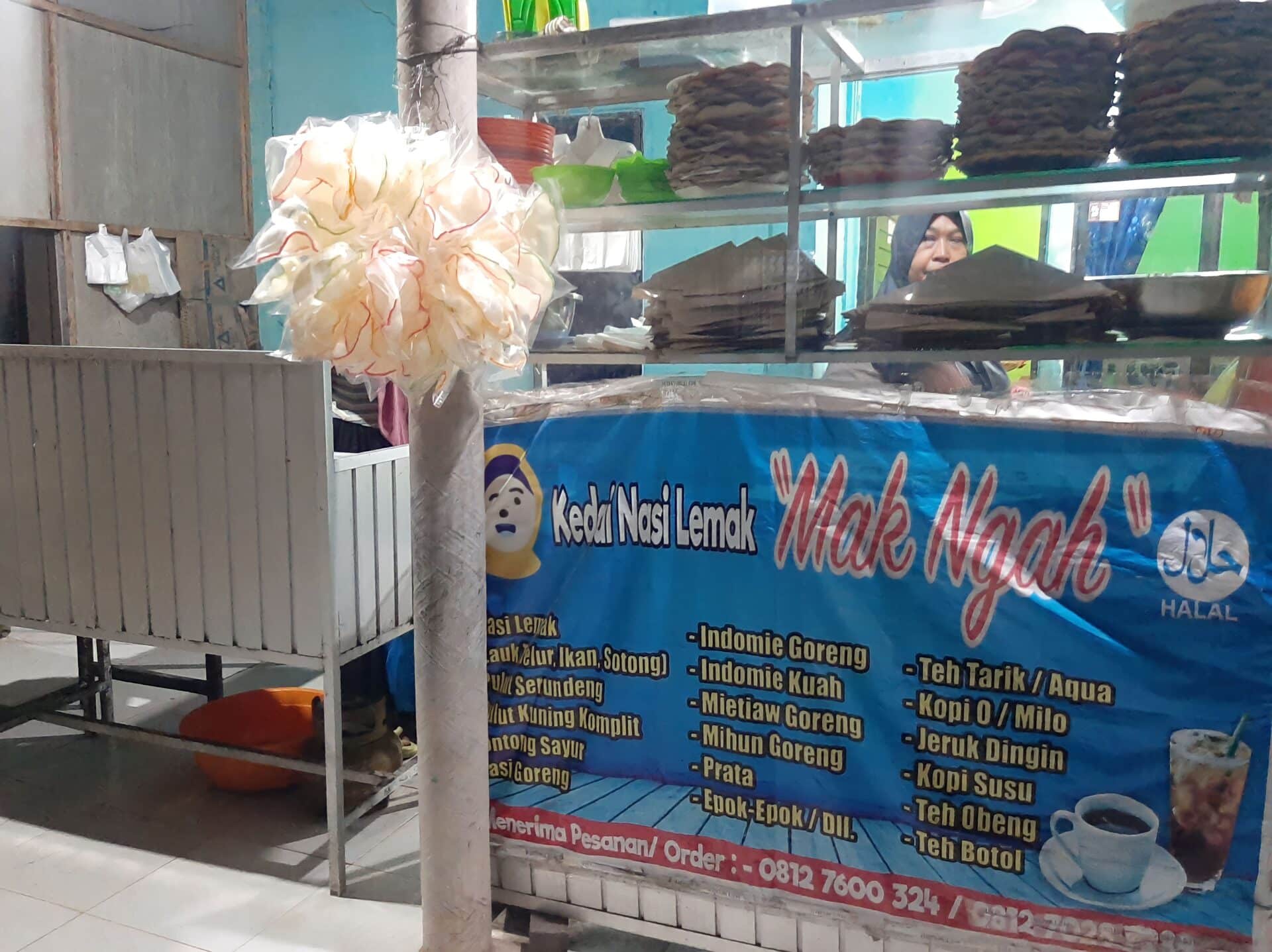
Me and my friends finally vacated the table at which longing and laughter had been served up together. Several hours had been filled with recollections, and with excited talk of the future. Each person gave money to Lela, who later would pay our joint order to Mak Ngah. We queued up to go down the spiral staircase one by one.
In the motorbike parking space, a friend yelled out: “if not for Mak Ngah, our group would turn into a gravesite – crickets.” We laughed, and deep down, I agreed with the joke. After saying goodbye and waving, engines were revved. Lela and I turned left, exiting the alley. After tonight, maybe we will all go back to infrequent encounters. No problem: as long as this nasi lemak resto is here, there will be another reunion.
Yearning has a taste, for we coastal kids of Tanjung Riau, Batam, and that taste is oily, spicy, and delicious.
© Dina Hameed
English translation © Sarah Leys
Commissioning editor: Wahyu Nur Cahyo




